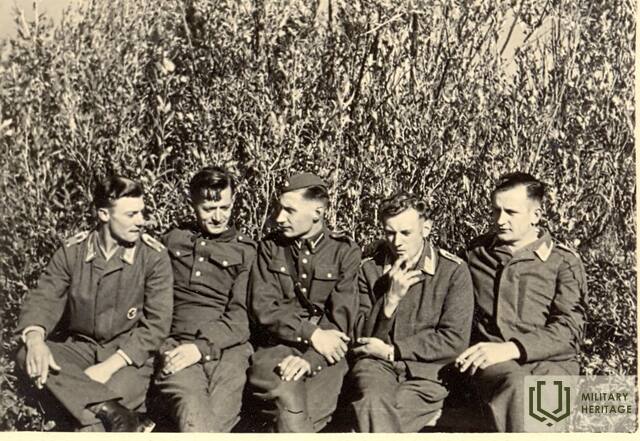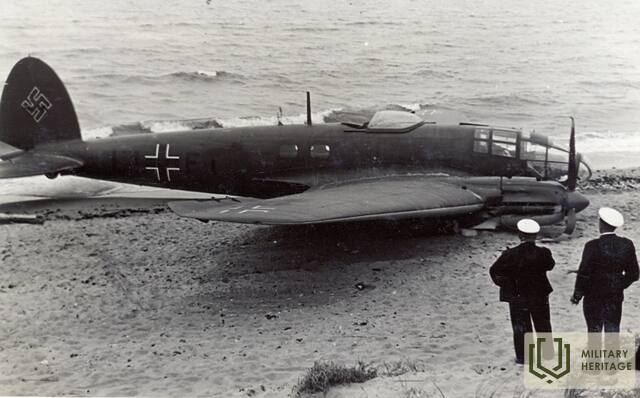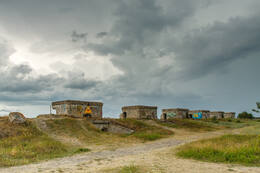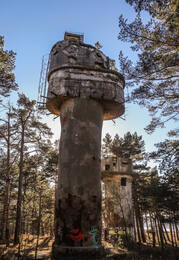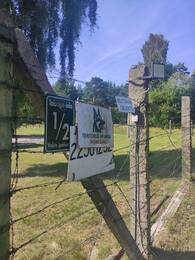Karosta – vokiško He-111 nusileidimo vieta Liepojos paplūdimyje 1939 m.
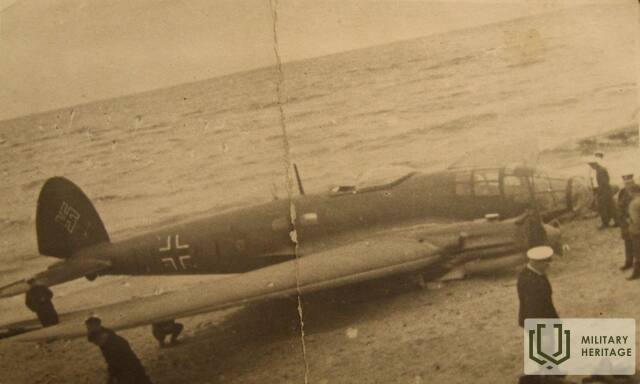
1939 m. rugsėjo 11 d. vokiečių bombonešis „Henkel He-111“, reidavęs Lenkijos miestus, naktį nukrypo nuo kurso ir avariniu būdu nusileido Liepojos paplūdimyje. Šis įvykis aprašytas Liepojos gyventojo ir Kuržemės divizijos ryšių kuopos karininko Vilio Zobenso atsiminimuose. Nusileidimo vieta gamtoje nepažymėta. Apytikslės koordinatės yra N 56.59368° E 21.01598° – paplūdimyje netoli Šiaurinių fortų.
Ankstų rugsėjo 11-osios rytą visus sutrikdė žemai skraidančio lėktuvo triukšmas. Išėję į lauką, pamatėme didelį, pilką lėktuvą su juodais kryžiais ant sparnų. Apskridęs kelis ratus aplink mūsų štabą, jis nusileido paplūdimyje. Nuvykome ten. Jis buvo nusileidęs tiesiai ant jūros kranto. Išlipo trys pilotai – du vokiečių karininkai ir vienas instruktorius. Kuopos vadui paklausus, kas nutiko, jie atsakė, kad buvo reido metu Lenkijoje, bet pasiklydo dėl sugedusio kompaso ir negalėjo grįžti į savo bazę. Nuvežėme juos į štabą ir parodėme kambarius viename kambaryje. Tiems vyrams karas dabar buvo pasibaigęs, nes pagal įstatymą jie turėjo būti internuoti. Maisto jie gavo iš karininkų klubo, kuriuo nebuvo patenkinti ir norėjo pasikalbėti su Vokietijos konsulu Liepojoje. Konsulas kitą dieną atvyko į kuopą ir sutvarkė maitinimą taip: konsulas sumokėjo už pietus, kuriuos užsisakė viešbutyje Liepojoje. Juos atnešė kuopos kareivis. Aš kalbėjausi su vokiečių instruktoriumi – vairuotoju. Jis buvo labai arogantiškas ir Hitlerio gerbėjas. Kuopos vadas taip pat turėjo su jais visokių problemų. Visi džiaugėmės, kai spalio 1 d. jie buvo perkelti į Rygą.
Vilis Zobensas, kilęs iš Liepojos, Kuržemės divizijos ryšių kuopos pulkininkas leitenantas, tarnybą Latvijos armijoje pradėjo 1925 m. 1-ajame Liepojos pėstininkų pulke. Tarnybos metu jis matė sovietų kariuomenės įžengimą į Latviją.
Zobensas, V. Atsiminimai, Liepājas Vārds (Latvijos liaudies frontas). 1992 m.
Susijusi laiko juosta
Susijusios vietos
Liepojos šiaurinis fortas ir 1-oji baterija Karostoje
Šiauriniai fortai yra geriausiai žinoma ir vizualiai įspūdingiausia Liepojos tvirtovės dalis. Juos XIX a. pabaigoje pastatė Rusijos caro armija, o istorinis jų pavadinimas – 1-oji tvirtovės baterija.
1908 m. lapkritį, praėjus mažiau nei 10 metų po Liepojos tvirtovės pastatymo, ji nustojo veikti, nes jos statyba buvo pripažinta strategine klaida. Dalis patrankų buvo išardytos ir išvežtos į Kauno tvirtovę Lietuvoje, o kitos – išlydytos. Fortifikaciniai statiniai buvo du kartus susprogdinti, siekiant sunaikinti įtvirtinimus. Iki šių dienų išlikusios detalės yra sprogimų metu nevisiškai sunaikintos artilerijos baterijos ir požeminiai statiniai. Kaip ir Karosta, Šiauriniai fortai sovietų okupacijos metu buvo uždara karinė teritorija. Šiaurinių fortų lankytojai turėtų būti labai atsargūs. Kaip ir kitose Latvijos pakrantės vietose, status Baltijos jūros krantas Karostoje yra pavojingas dėl galimų pakrantės nuošliaužų. Todėl po fortų griuvėsiais vaikščioti draudžiama.
Šiaurinėje tvirtovės dalyje buvo įsikūrusi viena iš keturių pakrantės gynybos baterijų – 1-oji baterija. Baterijoje turėjo būti šešios 6 colių (152 mm) 1892 m. modelio „Canet“ sistemos patrankos, šešios 11 colių (280 mm) 1887 m. modelio patrankos ir dvi 57 mm „Nordenfeld“ priešlaivinės patrankos. Tik „Canet“ sistemos patrankos turėjo pakankamai ilgą šaudymo nuotolį, kad atlaikytų galimą Vokietijos karinio jūrų laivyno apšaudymą. Taigi, likviduojant tvirtovę, ginkluotė buvo sumontuota tik iš dalies.
Karosta, Liepojos karinis uostas (ekskursija)
Karosta yra didžiausia istorinė karinė teritorija Baltijos šalyse ir užima beveik trečdalį visos Liepojos teritorijos. Karosta – unikalus karinių ir įtvirtinimų pastatų kompleksas Baltijos jūros pakrantėje, turintis ypatingą reikšmę Latvijos ir pasaulio istorijoje bei architektūroje. Karostoje yra tokie karinio paveldo objektai kaip Šiaurinis molas ir fortai, Redanas, Karostos kalėjimas, Karostos vandens bokštas, Šv. Nikolajaus stačiatikių Jūros katedra, Oskaro Kalpako tiltas ir kiti.
Liepojos pakrantės artilerijos baterija Nr.2
Tarp daugelio Liepojos jūrų muziejaus eksponatų, Liepojos pakrantės artilerijos baterija Nr. 2 iki šiol yra paslaptingiausia vieta Liepojoje. Antrojoje baterijoje visada buvo įrengti įvairių valstybių karių šaudmenų sandėliai.
Liepojos tvirtovės 2-oji baterija buvo pastatyta toliau nuo pakrantės ir buvo apsaugota aukšta įtvirtinimų siena. Baterija buvo ginkluota 16 11 colių (280 mm) minosvaidžių, pagamintų 1877 m. modelio. Išardžius tvirtovę, čia buvo įrengti šaudmenų sandėliai. Dėl sprogimo pavojaus teritorija 130 metų buvo uždaryta visuomenei, saugoma, tačiau dabar čia įrengta paroda apie 1-ojo Kuršo divizijos štabo veiklą 1919–1940 m., taip pat eksponuojami 1-ojo Liepojos pėstininkų pulko, 2-ojo Ventspilio pėstininkų pulko ir Kuršo artilerijos pulko fotografiniai įrodymai.




